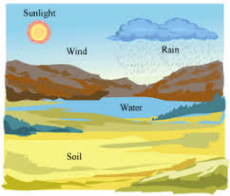

GCSE BIOLOGY REVISION: ECOLOGY
Please note: Text in bold is what the AQA GCSE biology specification requires an understanding of.
Students should be able to explain how a change in an abiotic factor would affect a given community given appropriate data or context.
Abiotic (non-living) factors which can affect a community are:
• light intensity
• temperature
• moisture levels
• soil pH and mineral content
• wind intensity and direction
• carbon dioxide levels for plants
• oxygen levels for aquatic animals.
In the previous article we discussed how temperature, light intensity, moisture levels and soil and mineral content affect communities.
Wind strength and its direction influences where organisms are found as many prefer locations that are more sheltered. Plant seeds are more likely to be found there and germinate. Animals that depend on such plants are likely to be found within these locations. Wind strength can also influence the growth of organisms.
Carbon dioxide is essential for plant photosynthesise. When levels are high, stomata open, increasing gas exchange. Carbon dioxide is used in reactions to make carbon compounds, for example glucose. Carbon compounds are used for growth. Thus, areas that have high levels of carbon dioxide are excellent for optimal plant growth creating high crop yields. Shortage of carbon dioxide limits growth.
Animals need oxygen. However, organisms that live in water use different mechanisms to obtain oxygen. Oxygen dissolves in water from oxygen in air and oxygen produced by aquatic plants. High levels of oxygen in aquatic areas make it ideal for organisms to live in. Polluted areas lack oxygen, some species can live in these conditions, like sludgeworms. Therefore, if you see some sludgeworms in the water, that is a good indicator (a bioindicator) that the water is polluted.
Some more bioindicators:
Stonefly nymph and mafly larva found in clean waters.
Freshwater shrimp and caddis fly larva found in relatively clean waters.
Bloodworm and water louse found in moderately polluted waters.
Red-tailed maggots found in highly polluted waters.
In very high polluted waters, no insects will be found.
Students should be able to extract and interpret information from charts, graphs and tables relating to the effect of abiotic factors on organisms within a community.
Advise for this section of the specification have already been discussed.
Students should be able to extract and interpret information from charts, graphs and tables relating to the effect of biotic factors on organisms within a community
Advise for this section of the specification have already been discussed.
Students should be able to explain how a change in a biotic factor might affect a given community given appropriate data or context.
Biotic (living) factors which can affect a community are:
• availability of food
• new predators arriving
• new pathogens
• one species outcompeting another so the numbers are no longer sufficient to breed.
Biotic factors are living factors that contribute to the community.
Availability to food is vital for animal survival. Areas that are rich in food supplies are homes to large varieties of species, for example rainforests. Deserts and polar regions have less available food, therefore have fewer species.
image-https://socratic.org/questions/does-a-community-include-abiotic-factors-explain

0 Comment:
Be the first one to comment on this article.